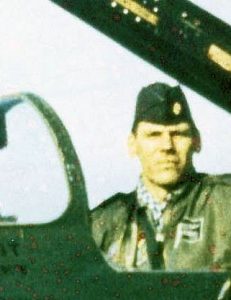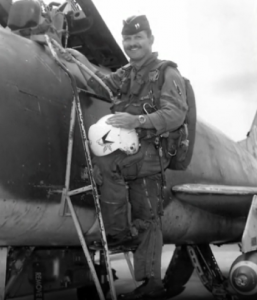Author, Kelly Irving, Back Seat, “Misty 66”
Frank Kimball, Front Seat, “Misty 61”


On 20 November 1968, Frank Kimball and I briefed for the midday mission, call sign Misty 41. Misty briefings were not the local how to start, taxi, takeoff, blah, blah, blah, BS. They were straight to the heart of it, where are we going, what are we doing, and how are we going to do it affairs. Also, I never heard a briefing that didn’t end with: What We’re Going To Do If We Take A Hit: Level the wings, stroke the ‘burner, start a climb, and clean the wings was usually the plan.
As we climbed out toward The Trail in Laos, we discussed the differences between the environment in North Viet Nam and Laos. Since the bombing halts a few weeks earlier, we were having to play in a new ballpark. Frank is up front flying, and I’m in the back working the maps, ready to communicate with and coordinate with any strike aircraft that came our way. (As an aside, during that period of my life, the term GIB was reserved for the poor bastards relegated to the rear cockpit of the F-4, real pilots who didn’t get to fly from the front seat. Later, in 1972, that would change to a term of endearment for the non-pilot Weapons Systems Operators in that rear cockpit helping to save my ass on a regular basis up around Ha Noi. Misty pilots usually alternated seats every other mission. Ah, but I digress.)
The weather was crummy that day. As we were learning our way around, I looked down through a break in the clouds and saw a HALFTRACK, A PRIME MOVER! We needed some ordnance now! None coming! I thought that we could pinpoint the target and put a strike in after tanking up and giving some time to get a strike flight inbound. So, we committed The Sin of the Second Pass. (For additional details on this particular sin, check with Rutan, Detwiler, and perhaps Wells Jackson.) As we went through and looked at our prize again, I got the impression of muzzle flashes, the wings leveling, the afterburner lighting, and the nose going up into a climb. We cleaned the wing as Frank says, “We’ve taken a hit. We’re gonna have to get outta this thing.” Frank takes it out of burner and it seems to be running smoothly for the moment. I say, “Not yet, not here, not now. Those are NOT friendly people down there!!”
This exchange went on for a couple of iterations as the AC electrics died, and the hydraulics died. The only things left were the battery and the still-running engine. The hydraulics did not lock up. They just went slack. The wings were level, we were trimmed for 300 KIAS, climbing with absolutely no control. We were simply passengers along for the ride. About 10 minutes after getting hit, the engine flamed out and we started coming down like a set of car keys. While all of this was taking place, we had made radio contact with the Search and Rescue (SAR) force as they got airborne out of Da Nang.
Now descending at 330 KIAS with the imminent terrain conflict becoming a rising priority, we tidied up and got ready to go. I sat up straight and told Frank that I was ready. BOOM! The canopy went. Then nothing! Several seconds later BOOM, the seat went. I tried to beat the seat as taught, and my reward for that effort was to have my hand knocked into the something-less-than-330-KIAS slipstream, which led to further complications a few seconds later.
The delay between canopy and seat was due to Frank’s realization that his chin strap wasn’t fastened. I can still visualize him peering into one of those little mirrors on the inside of the windshield frame as though he were checking for food between his teeth. He ejected both of us, meaning I exited first (zero-second lanyard not connected), then his system went (zero-second lanyard connected). That circumstance led to his exit and parachute opening being almost instantaneous while mine was opening more slowly using the barometric/timing system. Frank noted my chute risers and shroud lines wound up tight and thought that I was a goner. Then, he noted me spinning like a top resulting in a normal canopy.
Just minutes after getting on the ground, the Sandys and Jollys flew right over us. We made contact, followed instructions, and got pulled out of there about an hour later.
One more item of note: The helicopter pilot was the Rescue Detachment Commander on his first operational mission. His anxiety level may have been as high as ours, for in each case he began transitioning to horizontal flight before we were clear of the treetops. We may be among the very few to be awarded the Purple Heart for wounds inflicted by enemy trees. — Kelly Irving
Epilogue: Less we forget…Ron Thurlow, a SEA SAR expert, provided this information about the SAR forces who rescued Frank and Kelly that day.
Low Bird (pickup acft): HH-3E “Jolly Green 33”; AC – Lt Col John J. Devlin Jr (age 44); CP – Maj Herman C. Stafford Jr. (age 40); FE – MSgt Charles L. Manes; PJ – SSgt Eugene L. Nardi
High Bird (cover acft): HH-3E “Jolly Green 21”; AC – Capt Jerry M. Griggs; CP – Capt Don W. Wiegard
FE – TSgt Arthur L. Ambrose; PJ – Sgt Thomas T. Winters
“Spad 11”: Maj W. T. Frankam; “Spad 12”: Capt W. L. Thompson
I also found a short article on the SAR from the Dec 11, 1968 issue of Pacific Stars and Stripes. Here was one quote I found interesting: “‘Actually, it wasn’t too rough, although we did almost hit some tree limbs while we were extracting the men from the slope.’ added Stafford, age 40, from Bluefield, WV.” — Ron Thurlow
For more about Frank Kimball go to https://supersabresociety.com/biography/kimball-frank-t/
